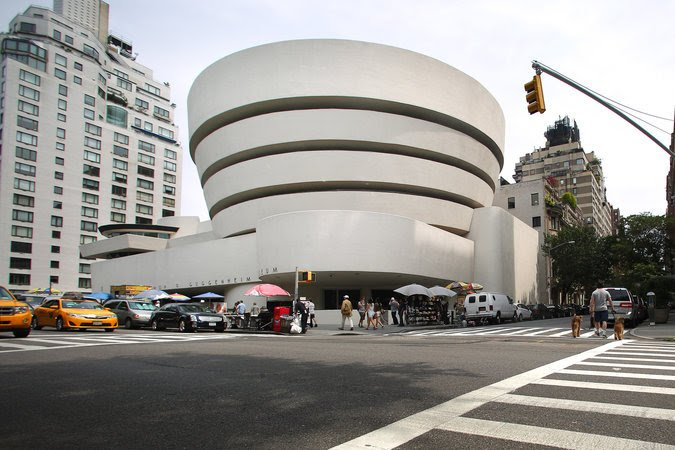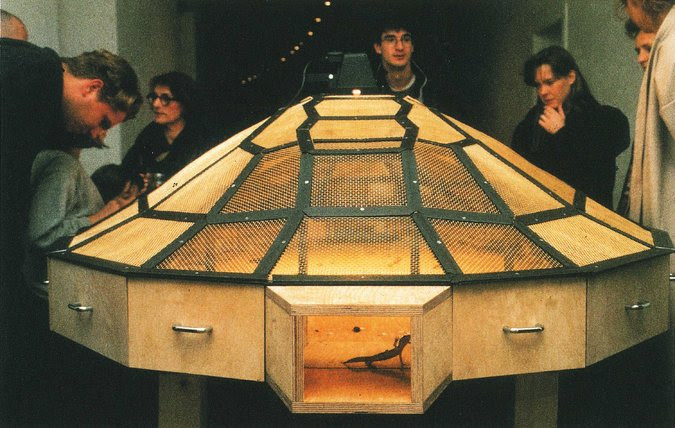정준모
Guggenheim Museum Is Criticized for Pulling Animal Artworks

Sun Yuan and Peng Yu’s “Dogs That Cannot Touch Each Other” (2003), a seven-minute video with eight American pit bulls on eight treadmills. The work was one of three pulled from a coming show at the Guggenheim. CreditGalleria Continnua, San Gimignano, Beijing, Les Moulins, Habana
Artists and museums are often in the thick of free speech debates — think of Rudolph W. Giuliani’s battle with the Brooklyn Museum over a Virgin Mary artwork with elephant dung and more recently a fight over an exhibit that evoked Emmett Till’s mutilated corpse. Typically the art world holds its ground, emerging bruised but resolute.
But in two recent controversies, the protesters seem to be winning.
On Monday, the Guggenheim decided to pull three major works from a highly anticipated exhibition after pressure from animal-rights supporters and others over the show “Art and China After 1989: Theater of the World.” This, together with the Walker Art Center’s recent move to dismantle Sam Durant’s sculpture “Scaffold” in response to protests, has art leaders concerned that museums are setting worrisome precedents when threatened with organized pressure tactics.
“When an art institution cannot exercise its right for freedom of speech, that is tragic for a modern society,” the artist Ai Weiwei said in a telephone interview, referring to the Guggenheim’s decision. “Pressuring museums to pull down artwork shows a narrow understanding about not only animal rights but also human rights.”
The three works in the Guggenheim show, which opens Oct. 6, were created between 1993 and 2003 and were intended to symbolically depict oppression in China. One video, “Dogs That Cannot Touch Each Other,” shows four pairs of pit bulls on nonmotorized treadmills, trying to fight even as they struggle to touch. Another video, “A Case Study of Transference,” shows two pigs mating in front of an audience. And an installation — “Theater of the World,” a central work of the show — features hundreds of live crickets, lizards, beetles, snakes, and other insects and reptiles under an overhead lamp.
Protesters marched outside the museum over the weekend, and an online petition demanded “cruelty-free exhibits” at the Guggenheim. The museum said in a statement Monday that the works were being removed “out of concern for the safety of its staff, visitors and participating artists.” The museum added: “Freedom of expression has always been and will remain a paramount value of the Guggenheim.”
A museum spokeswoman, asked to describe any threats or security issues, including whether the police had been notified, declined to discuss specifics. But the spokeswoman, Sarah Eaton, added, “The tone in both the petition comments and the social media postings, calls and emails was markedly different from what we’ve seen before and required us to take the threats very seriously.”
The Guggenheim has also been a target of protesters in recent years over its decision to build a museum in Abu Dhabi despite widespread concerns about labor conditions there. The Guggenheim has not withdrawn those plans.

Protests prompted the Guggenheim, above, to pull works from “Art and China After 1989: Theater of the World” before the show opens. CreditChang W. Lee/The New York Times
For many artists and museum professionals, the latest moves at the Guggenheim and the Walker amount to an artistic capitulation in the face of heightened political sensitivities that have been amplified by social media.
“Museums are here to show works that are difficult, uncomfortable, provocative,” said Tom Eccles, executive director of the Center for Curatorial Studies at Bard College. “The chilling effect of this of course is museums will now look to make exhibitions that won’t in any way offend.”
Similarly, PEN America called the Guggenheim’s decision “a major blow to artistic freedom.”
Others say the Guggenheim should have used the controversy as a moment to engage the public about difficult art.
“It’s just surprising that there was no call to see the side of the artists,” Mohini Dutta, a transmedia designer who teaches at Syracuse University, wrote in an email. “It’s sad, but not surprising that a populist institution like the Guggenheim caved, instead of using it as an opportunity to have a larger dialogue about consent, living props and uncomfortable art.”
In the case of the Walker, Dakota Indian leaders argued that Mr. Durant’s two-story structure in the Minneapolis Sculpture Garden — which aimed to evoke gallows throughout United States history — brought back painful memories and trivialized the executions of the United States-Dakota war in 1862.
More often in the past, museums have resisted such pressure. In March, a small group of protesters blocked Dana Schutz’s painting in the Whitney Biennial based on open-coffin photographs of the mutilated body of Till, the teenager who was lynched by two white men in Mississippi in 1955. They objected to a white artist’s using — and potentially profiting from — an image of violence against a black person and urged that the painting not only be removed from the show but also destroyed. The Whitney kept the painting on view.
Some applauded the Guggenheim’s decision.
“It’s the right thing to do,” said Stephen F. Eisenman, an art history professor at Northwestern University who has written extensively about the ethics of using animals in art. “The works are cruel and support cruelty and give sanction to animal abuse, and it’s right that they should pull them.”

Mr. Eisenman said the Guggenheim should have gone even further in correcting its errors and issue an apology “for sanctioning such abuse.” Instead, he argued, museum officials “covered up what they’ve done by a claim that they did so on the grounds of security.”
Ingrid Newkirk, the president of People for the Ethical Treatment of Animals, who had called on Richard Armstrong, the Guggenheim’s director, to remove the artwork, also commended the museum “for withdrawing these vile acts of cruelty masked as creativity.”
“China has no laws protecting animals, so withdrawing these pieces may help the country and its artists recognize that animals are not props and that they deserve respect,” she said.
Controversial art installations and even some paintings regularly prompt an outcry. The Brooklyn Museum faced off against Mayor Giuliani over Chris Ofili’s Virgin Mary. In the current Venice Biennale, some have objected to the use of Amazonian Huni Kuin tribe members in the artist Ernesto Neto’s tent and to the artist Olafur Eliasson’s use of Venice’s migrants in his workshop installation. In both cases, the artwork remained in place.
The Dobermans used by Anne Imhof in the German Pavilion at the Venice Biennale did not provoke high-profile objections; she won this year’s top prize.
But Sarah Cohen, an art historian at the University at Albany whose research focuses on artistic representations of animals, questioned why the Guggenheim included the works at all.
“The curators themselves do not appear to have considered very deeply the problem of humans forcing certain behaviors in animals,” she said in an email. “Nor did they apparently stop to consider that using pigs as performers to ‘inform’ human spectators about their cultural hangups is a shopworn strategy — as old as dancing bears and the circus.”
“In my opinion,” she added, “the exploitation of animals to make artistic points is, well, bad art.”
Guggenheim, Bowing to Animal-Rights Activists, Pulls Works From Show

Huang Yong Ping’s “Theater of the World,” which features live insects and reptiles.CreditHuang Yong Ping/Guggenheim Abu Dhabi
Facing an avalanche of criticism, the Guggenheim surrendered late Monday and said it would remove three major works from a highly anticipated exhibition of art by Chinese conceptual artists, including the signature piece of the show, which opens next month.
The museum, in Manhattan, made the decision after it had come under unrelenting pressure from animal-rights supporters and critics over works in the exhibition, “Art and China After 1989: Theater of the World.” Protesters marched outside the museum over the weekend, and an online petition demanding “cruelty-free exhibits” at the Guggenheim had been signed by more than half a million people as of Monday night.
The three works, which all involve animals, are “Dogs That Cannot Touch Each Other,” “Theater of the World” and “A Case Study of Transference.” The pieces were among about 150 works selected for the show, mostly experimental art and many of them shocking, intended to challenge authority and use animals, in video, to call attention to the violence of humankind.
[Guggenheim Is Blasted by Artists for Pulling Works Involving Animals]
The museum planned to show a video of “Dogs That Cannot Touch Each Other,” in which four pairs of dogs try to fight one another but struggle to touch because they are on nonmotorized treadmills, and a video of “A Case Study of Transference,” which shows two pigs having sex before an audience. But “Theater of the World” was the signature work of the show and was going to feature hundreds of live insects and reptiles milling under an overhead lamp.

Xu Bing’s “A Case Study of Transference,” 1994. The artwork originally featured live pigs, but the Guggenheim was going to use a video of the Beijing performance. CreditXu Bing
The museum said the works were being removed “out of concern for the safety of its staff, visitors and participating artists.”
“Although these works have been exhibited in museums in Asia, Europe and the United States, the Guggenheim regrets that explicit and repeated threats of violence have made our decision necessary,” it said in a statement posted on its website. “As an arts institution committed to presenting a multiplicity of voices, we are dismayed that we must withhold works of art. Freedom of expression has always been and will remain a paramount value of the Guggenheim.”
Criticism of the show grew quickly online, on social media and on animal-rights websites, with the initial focus on “Dogs That Cannot Touch Each Other.” The museum tried to quell the backlash last Thursday, releasing a statement acknowledging that the work was difficult to view but encouraging patrons to consider what the piece “may be saying about the social conditions of globalization and the complex nature of the world we share.”
A spokeswoman for the museum said Thursday that “it was not a question that it would stay in the exhibition.”
But the criticism only grew over the weekend. On Monday, the president of the People for the Ethical Treatment of Animals said that only “sick individuals” could enjoy watching “Dogs That Cannot Touch Each Other,” and the American Kennel Club said that dogfighting “should not be displayed in any manner and certainly not as art.”

“I am hearing about this for the first time,” he said.
Peng Yu, who created “Dogs That Cannot Touch Each Other” with her husband, Sun Yuan, denied her art was animal cruelty.
“These dogs are naturally pugnacious,” Ms. Peng said in an interview last year.
Reached in Beijing on Tuesday, Ms. Peng blamed the controversy on a recent article about the exhibition. “I don’t want to talk about this anymore,” she said, adding that the dogs were examined by veterinarians before and after they were used in the performance.
The Guggenheim originally agreed to include the third piece, “A Case Study of Transference,” but only as a video of a Beijing performance. The boar and sow are stamped with gibberish composed of nonsensical English words and invented Chinese characters — intended to make patrons consider the relationship between the West and China.
FAMILY SITE
copyright © 2012 KIM DALJIN ART RESEARCH AND CONSULTING. All Rights reserved
이 페이지는 서울아트가이드에서 제공됩니다. This page provided by Seoul Art Guide.
다음 브라우져 에서 최적화 되어있습니다. This page optimized for these browsers. over IE 8, Chrome, FireFox, Safari